Did a Cadillac boat penned by Brooks Stevens inspire the 1959 Cadillac’s tail fins?
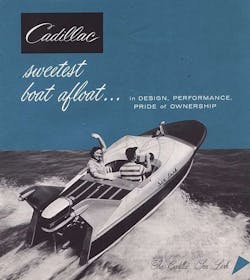
The history of tail fins is well documented. They first appeared on the 1948 Cadillac, the first all-new car from Cadillac after the end of World War II. The rear end of the ’48 Cadillac tapered down, much like that of cars in the immediate prewar period. To give the back of the new Caddy a more modern look and to visually raise the rear profile of the car, senior designer Frank Hershey’s team swept the fender line up into a fin.
According to Detroit lore, the fins were ultimately inspired by a wartime field trip to the U.S. Army Air Corps’ Selfridge Field that GM styling chief Harley Earl took with his design staff. As part of the war effort, the team had been assigned graphic design work for the U.S. military, including the illustration of flight training manuals. Earl was taken by the Lockheed P-38 Lightning and its twin rudders. The fighter aircraft also had an impact on his team: GM designer Ned Nickles’ early drawings for the ’48 Cadillac depict a vehicle that looks more like an airplane missing its wings than the cars of its era.
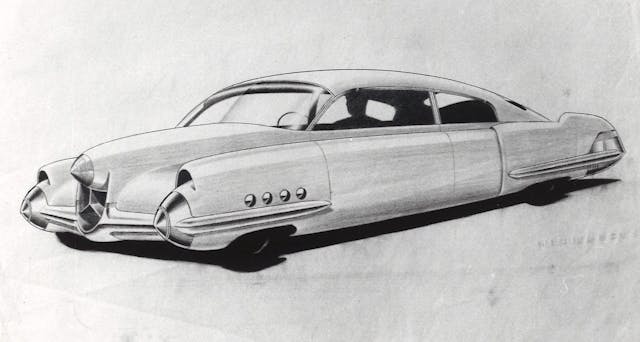
What began as a new look in 1948 became de rigueur in Detroit styling studios by the mid-1950s. Peak fin was reached with Cadillac’s 1959 models. The fins on the fifty-nines weren’t simply tall; long, bullet-shaped red taillights extended from nacelles shaped into the fins’ sides.
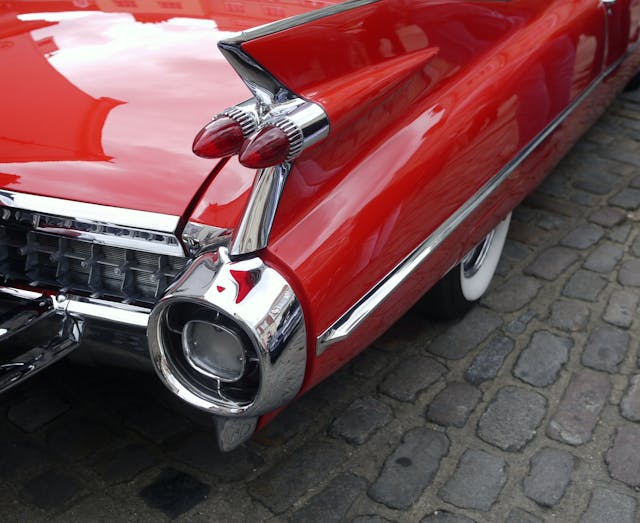
At a company like General Motors, no one designer was responsible for an entire vehicle. The team that is generally attributed with drafting the ’59 Cadillac lineup included Dave Holls, Chuck Jordan (who eventually headed GM styling), and Ed Glowacke. When the 1959 models hit the market, Bill Mitchell was just taking the reins at GM styling, Harley Earl having reached GM’s mandatory retirement age of 65 in late 1958, so Earl undoubtedly had considerable influence in the shape of those cars.
With so many GM styling heavyweights involved in the ’59 Caddy, it may come as a surprise that those famous ’59 fins may have been influenced by an independent designer’s earlier work on a different kind of Cadillac—a water-going vessel.
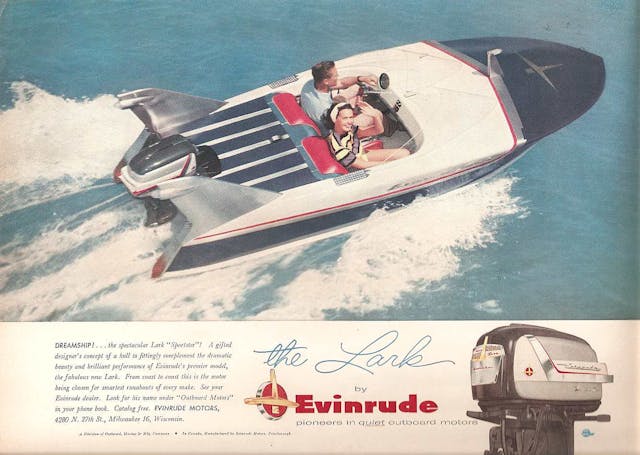
One of the most notable independent car stylists in the 1950s and 1960s was Brooks Stevens, whose portfolio included work for Willys, Harley-Davidson, Kaiser, Alfa-Romeo, Paxton Superchargers, Jeep, Studebaker, Volkswagen, and American Motors. He also penned the neoclassic Excalibur models and the Oscar Meyer Weinermobile. In 1956, Stevens was commissioned by the Outboard Marine Corporation, makers of Evinrude outboard boat motors, to design what today we’d call a concept boat, the Cadillac Sea Lark, to promote the Lark family of engines.
As with the car industry’s big auto shows in Geneva, Detroit, and Shanghai, the recreational marine business has important trade shows. Back in the ’50s, the two most important events were the Chicago and New York International Boat Shows. Evinrude wanted to make an, ahem, splash at those expositions, so it turned to Stevens. The marine company already had the beginnings of a relationship with Stevens, since he had previously styled the Lark’s cowling and, more than a decade later would go on to design the Evinrude Rooney Lakester car/boat combo.

You may be wondering how a boat designed for Evinrude come to be called a Cadillac … and how it had any relation to the Cadillac division of General Motors. The answers to those questions have to do with Michigan’s diversified economy.
While most people know that Detroit is the Motor City and that Michigan has been home to many, many car factories and their suppliers, Michigan also has a long history with computers (Burroughs was based in Detroit), agriculture, pharmaceuticals (the Pfizer COVID-19 vaccine is being manufactured in Portage, near Kalamazoo), and furniture. There’s also the Great Lakes-related marine industry, which ranges from recreational dinghies to ocean-going freighters. In 1893, the Wagemaker Company opened in Grand Rapids to make office furniture, including filing cabinets and roll-top desks. With its expertise in woodworking, in 1953 it diversified by starting the Cadillac Marine and Boat Company in Cadillac, Michigan, to manufacture wooden boats.

Why would Wagemaker locate a boat company in a small town in northern Michigan at least an hour away from any of the Great Lakes? At a time when Cadillac cars were considered “the standard of the world,” it was a boon to own a Cadillac brand name without needing permission from General Motors.
As the recreational boat industry adopted new technologies, Wagemaker also acquired U.S. Molded Shapes in Grand Rapids, a company that made fiberglass boat hulls. With a hand in each market, in 1955 the furniture maker also started Empire Boats, which used hybrid construction mixing wood, fiberglass, and aluminum. The business model took hulls from U.S. Molded Shapes up to Cadillac, where they were finished and then marketed under the Wagemaker Wolverine brand. In two short years, production soared to 5500 boats per year.
In 1954 William Scott, executive vice president of Outboard Marine, proposed to Stevens that he take Evinrude’s most powerful outboard model, the Lark, and dress it up with custom trim, much like Cadillac had dressed up its flagship car to make the Eldorado.

Stevens took Scott’s suggestion of automotive influence one step farther. As he told Sports Illustrated magazine in 1957:
Let’s build, for the first time, a dream boat, with styling integrated with the Lark […]
How could I go wrong? Look at the way people are going for the Jaguar, the MG, the Mercedes-Benz, and for our American offerings, the Thunderbird and the Corvette. Why not a sports boat, for the guy to take his blonde out in? In designing this boat, I put the gearshift in the middle, just the way it is in a Jaguar and a lot of the others. I made two bucket seats, and added trim, coloration, the whole thing. I even went so far as to put in an airplane-type steering wheel.
The fins where there because fins were it—because fins were going to be it. This was before Chrysler*. I exaggerated. I wanted a flamboyant conversation piece. But in doing it, I at least incorporated a retractable ski-tow reel inside the fins. In other words, I made a functional reason for my foppery.
People saw the romance of the fast-looking boat. The chic boat for the youth of the nation, and … there are plenty of 60-year-old youths riding around in the suburbs with hats on.
Stevens came up with a radical two-seat sport boat, with double-bubble windscreens and sleek lines, wearing a three-tone, blue, white, and silver paint job complete with red striping and tail fins that extend about a foot higher than the top of the Lark outboard motor. The fins rose as high as three feet, with nacelles that terminated beyond the trailing edges. In some photos there appear to be clear, bullet-shaped extensions to the nacelles, perhaps running lights. The trailing edges of the fins and hull create a concave V shape, much like the trailing edge of the ’59 Cadillac’s fins. Outboard Marine contracted with Cadillac Boat to bring Stevens’ concept to reality.
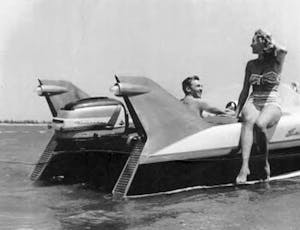
Steven’s fins on the Sea Lark look so much like those on the ’59 Cadillac that at first glance you might think he was influenced by the luxury car’s design, but Stevens designed the Sea Lark for the 1956 trade shows, about the same time that Holls, Jordan, and Glowacke would have been starting work on their Cadillac. If there was mutual influence, it went the other direction.
Michael Lamm wrote the encyclopedia on American car design, A Century of Automotive Style: 100 Years of American Car Design, with the late Dave Holls. I sent Lamm some images of the Cadillac Sea Lark and he said that Holls never mentioned it, but that the similarity was interesting. Lamm suggested that perhaps Holls had a hand in the design of the Sea Lark, but Clifford Brooks Stevens is the only name on the design patent, assigned to OMC (Outboard Marine Corporation). It’s not unreasonable to suggest that Stevens’ boat might have been seen by the Cadillac designers: Not only was the Sea Lark featured in Sports Illustrated, it even made the cover of Newsweek.
As mentioned, the Cadillac Sea Lark was a literal showboat, with no production plans, though it was listed on Cadillac Boats’ 1957 price sheet at $1975 (about $18,600 in 2021 dollars). Perhaps as many as five were made, but most likely there were only two, one for each of the big boat shows.
Kevin “KevFin” Mueller is a classic fiberglass boat enthusiast and restorer. He tracked down the one surviving Sea Lark, which had long since lost its fins, and got permission from the owner to pull a mold from the hull and constructed an accurate** replica. That replica was bought by the Disney organization, which currently has it on display at the Boathouse restaurant at Disney World in Florida. Another replica has been made by a Canadian enthusiast, Brad Lake.
The Sea Lark may have never seen mass production, but the far more popular ’59 Cadillacs may just owe their fabulous fins to this little-known, high-style watercraft.
*A reference to Virgil Exner’s “Forward Look” cars of 1957, which put the tail-fin craze into high gear.
** The original Cadillac Sea Lark used hybrid aluminum, wood, and fiberglass construction. The replica is fiberglass. An attempt was made at restoring the original laminated wood hull, but it proved prohibitively expensive.
Editor’s note: Ronnie Schreiber’s commendable job explaining the undeniable connection between the Cadillac Sea Lark sport boat’s striking tailfins (and those that followed on 1959 Cadillac production cars) merely scratches the surface of this Exner-era innovation. As always, there’s more to the story.

